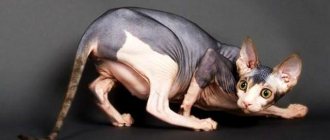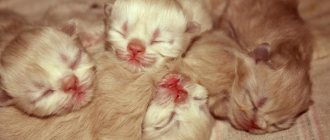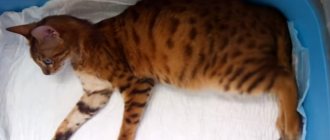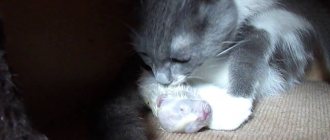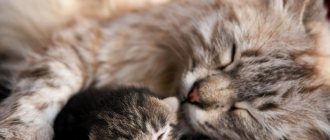Why do kittens die
Among the reasons and factors, the following stand out::
- Heredity . Mortality in the family (both maternal and paternal) greatly increases the likelihood of death.
- Genetic abnormalities . In the development of the fetus, deformities, mutations, and various disorders can be observed. Too frequent births, more than 2-3 times a year, can also lead to this.
- Imbreeding . If a closely related female and male mate, the life of the newborn kitten is at risk.
- Blood incompatibility . When breeding purebred cats, this is a key criterion. Blood type mismatches increase the risk of a stillborn kitten.
- Mutilation . Bumps and bruises, falls - these are factors characteristic of stray cats who are in constant danger. Painful contractions appear, and the cat may not give birth even in a day.
- Parasitic diseases . Individuals with chlamydia, toxoplasmosis, herpes, and inflammatory processes in the reproductive organs have little chance of a successful pregnancy outcome.
- Diet disorders . The lack of the proper amount of vitamins and minerals interferes with the favorable development of the fetus and poses a threat to the life of the mother. The cat's activity decreases, and the fetus begins to become oxygen starved.
When can kittens be considered “premature”?
There are several signs by which you can accurately determine whether a kitten was born prematurely:
- Very low weight. It is believed that the weight of a normal kitten should vary between 91-105 grams. All babies whose weight does not exceed 87 grams can be considered premature. Note that the minimum possible weight when kittens still have a chance to survive is at least 57 grams. But, as world veterinary practice shows, the chances of survival for such babies are very, very small. In most cases, the cat does not feed such “bastards” and may even eat them. If you want to save their lives, you will have to feed the babies yourself.
- Premature kittens are very small.
- They have folded, wrinkled skin.
- On the chest, tummy and legs (and sometimes all over the body) the fur is very sparse, with “occasional” hairs sticking out of the skin.
- Such kittens are often unable to hold their heads upright, some cannot even crawl.
What to do if a kitten is born dead?
When a cat gives birth to dead kittens, it is mainly a moral blow for the owner.
The first step is postpartum resuscitation measures. In some cases, this helps save the kitten within 15-20 minutes after birth :
- The kitten should be turned down: the bubble is eliminated, which will leak bile from the mouth and lungs. Remains can be sucked out using a syringe.
- Two exhalations are made from the kitten’s mouth and nose. The mouth should completely cover the baby's face.
- You can check your heartbeat with a stethoscope. The chest is compressed with light pressure between the index finger and thumb.
As practice shows, if a cat gives birth to dead kittens, it is not possible to carry out resuscitation operations due to the lack of skills and appropriate equipment. In addition, we must not forget that diseases of a dead fetus can be transmitted to the cat's owner.
If there is no result, the dead baby is isolated from the mother and wrapped in a bag. When there is not one dead kitten, but several, each is isolated separately.
The second step is a consultation with a veterinarian. The specialist will perform an autopsy of the dead fetus and identify the factors that influenced the death. The female and male (if possible) should be seen by a doctor after two to three days, when the cat has recovered from the birth. The veterinarian’s task is to identify or refute the presence of inflammation in the reproductive part of the body and, if necessary, prescribe treatment.
Stages and timing of normal pregnancy
Cats become ready for pregnancy after six months of age. The optimal age is 6-9 months after birth. In different breeds, the process of growing up occurs differently and depends on the weight and size of the animal, conditions of detention and development.
Pregnant cat
Reference! Veterinarians believe that the first cat pregnancy should occur before 1.5 years of age.
The optimal pregnancy period is from 63 to 72 days. True, if there are 5-8 kittens, then birth may occur at 58-62 days and this will be normal. In other words, the gestational age is 2 months or 9 weeks.
As a rule, owners of purebred animals themselves organize the mating and know when the animal could become pregnant and they themselves begin to count the approximate period. After 2.5 weeks, the cat’s nipples become coral in color, and the belly begins to grow. You can conduct an ultrasound and find out the number of kittens after 15 days of pregnancy, and the enlargement of the abdomen also occurs due to increased appetite. The most accurate information can be obtained after the 40th day of pregnancy.
The fetuses in the belly begin to take on a cat-like appearance around mid-term. Ultrasound is considered the safest method of fetal counting, since careless and frequent palpations can harm the fetuses.
The final stage begins after 7 weeks, the animal becomes almost “round”, the female begins to behave strangely, the appetite is already decreasing, the animal sleeps a lot. A few days before lambing, the female becomes as restless as possible, her temperature drops and the nesting instinct manifests itself. White discharge begins from the uterus. Giving birth to a cat is much easier than to giving birth to a human. Everything happens naturally; there is no need to contact a veterinarian.
Animal ultrasound
Note! If an ultrasound or examination revealed suspected pathologies or possible natural problems. Or, such situations have already occurred in previous births
How many days before birth does milk appear?
Females produce milk to feed the future brood shortly before lambing. As a rule, this is 2-3 days. In some cases, this happened 8 days before the kittens were born. White discharge appears on the nipples, the nipples themselves swell and become more noticeable. Sometimes milk may appear late if the female is primiparous or very nervous. True, the first appearances can hardly be called milk; its composition and density are not the same as milk. This is called colostrum.
Reference! If a cat is nervous, you need to try to find the reason and eliminate it, so that after the birth of the babies she does not have problems with milk.
After lambing or 3-4 days after the appearance of colostrum, the cat begins to produce normal milk, which the kittens will feed on.
You need to pay attention to the behavior of kittens. If the kittens sleep well and behave calmly, there is enough milk
But if your sleep is poor and restless, most likely there is not enough milk. The reason for the lack of milk can be health problems, nerves and poor nutrition of the mother. To prevent kittens from going hungry, they can be “supplemented” with special mixtures from pet stores or warm cow’s milk using a pipette or pacifier. If childbirth has occurred, but colostrum has not appeared, you should purchase formula for the first time so that the kittens do not remain hungry. If milk does not appear over time, the animal should be shown to a veterinarian.
How to protect future offspring?
You can help your cat give birth to kittens alive and healthy through pregnancy prevention and preliminary preparation.:
- competent choice of a male means compatibility of blood groups, absence of hereditary diseases and cases of stillbirth in ancestors;
- It is not recommended to allow mating of related individuals;
- periodic diagnostics of a pet will identify infectious formations and reproductive problems in advance;
- in a veterinary clinic you can carry out deworming - elimination of parasites and worms;
Why do cats give birth prematurely?
Premature lambing in domestic, well-groomed cats is extremely rare . The reason may be one of the following factors :
- The animal was injured (fell, hit, accidentally got under the foot of someone in the household).
- If your pet goes outside, it can pick up an infection there. The disease will provoke early labor.
- The cat was stressed (she was very frightened, a child appeared in the house, renovations began, her beloved owner left for a long time).
- One kitten died in the womb. Here everything happens at the level of functions inherent in nature - the animal’s body spontaneously gets rid of the dead fetus.
- The cat feels a threat to its offspring. This happens very rarely. For example, if a pet lives in a private house and walks in the yard, the appearance of an aggressive dog among neighbors can cause the cat to give birth prematurely - she feels that she will not be able to protect the kittens and gets rid of the litter.
These are the most likely causes of premature birth in a cat. If the animal is already old (the cat is 7-8 years old or more), then the risk of premature pregnancy increases significantly.
Pedigree and selective breeds of cats may not bear their first litter. Their natural instincts are less developed, and pregnancy often occurs with complications.
Survival of prematurely born kittens
Almost every baby has a chance of survival. But it’s not the cat who will have to take care of it, but you. Remember that premature kittens are at an initial disadvantage; their vitality is significantly lower than that of their normal relatives. Despite all the care of the owner at home, such babies often do not survive.
Their body is very “fragile” and is more susceptible to various infectious diseases. They grow very slowly and develop much worse. If ordinary kittens are already running quite quickly by the end of the first month, then in premature babies by this time their eyes may just open and they may begin to crawl.
A comfortable external temperature is very important for them, since the thermoregulation system in such babies works extremely poorly. Alas, in many cases there is nothing you can do: the internal organs of premature kittens are often underdeveloped, which will inevitably lead to death (albeit not immediately).
Important! Please note that in cases where the baby, regardless of the characteristics of the food you use, constantly has digestive problems, everything is bad. Most likely, his digestive system is underdeveloped.
Symptoms of premature birth
In a normal pregnancy, the expectant mother begins to prepare for childbirth about a week in advance. This is easy to notice - the cat is fussing, looking for secluded places, meowing loudly, and eating poorly. But premature lambing can begin suddenly.
Signs of premature lambing:
- The cat has bloody or thin discharge.
- Her stomach became hard.
- The animal became lethargic or, conversely, fussed too much.
- The pet refuses water and food.
- Breathing has become faster, contractions (spasms in the abdominal area) are observed.
Massage
We emphasize once again that the digestive system of premature kittens is almost always underdeveloped. Because of this, in particular, pets almost always have serious problems with peristalsis. In order to somehow stimulate it, you need to regularly massage the abdominal cavity . It should be taken into account that even a cotton pad may be too hard for the extremely delicate skin of a premature kitten.
To avoid injuring the baby, turn on the tap, wait until warm (but not hot) water comes out and, directing it in a thin stream, massage the lower part of the kitten’s tummy, helping with your finger. Before doing this, it won’t hurt to cut your nails (yourself). If the kitten experiences discomfort during the procedure, its intestines will not be activated.
What to do
If possible, it is better to call a veterinarian immediately. If this is not possible, you will have to give birth yourself.
Kittens are considered viable if they are already 51 days old. They will not survive any earlier and there is no point in saving them.
Some advise giving the animal an injection to stop contractions (No-shpu, Papazol) in order to prolong pregnancy . But doing this without a doctor's examination is dangerous: perhaps one or more fetuses are dead, and if the cat's body does not get rid of them, blood poisoning will occur.
If the reason for early lambing has not been established, it is better not to interfere with the process. It's good that if the kittens are born alive, they have a chance to survive. Dead offspring should be immediately removed from the mother.
It is impossible to predict how long kittens will be born and how many there are in the womb. Sometimes the lambing process lasts more than a day. If the cat has not given birth within 5-7 hours, you should call a doctor.
Even if a cat gave birth to viable kittens prematurely and feels well, she still needs to be shown to a specialist. After all, something triggered the premature process. You should not bring a recently born animal to the clinic - this is a lot of stress for the cat; it is better to call a veterinarian at home.
On time or not?
Firstly, what is “premature” in the case of kittens? To answer this question, you need to know how long pregnancy lasts normally in these animals. If everything is in order, then the kittens are born after 64 days (approximately).
Depending on the breed, the physiological state of the pet, its feeding during pregnancy and other factors, the gestational age (normal) can vary within 55-67 days , and this cannot be considered a deviation from the norm.
The signs of this phenomenon are no different from the usual birth process: the cat meows, worries, looks for a suitable place, etc.
Only in cases where kittens were born between 40 and 50 days can we talk about premature birth . And such situations are called “childbirth” because the babies (at least hypothetically) are quite viable. Anything that happens earlier is called a “miscarriage.”
Kittens born at such a time are very premature and not viable. There are cases when a cat eats miscarriages, which is why the owners then cannot understand why it seems that the formerly pregnant pet does not “decide” to give birth.
reasons for the premature birth of kittens . These include:
- injuries (from falls, for example);
- infectious and non-communicable diseases;
- congenital pathologies, etc.
But, as veterinary practice shows, cats tolerate premature birth well. It's much worse for kittens. Therefore, after premature birth, you have to take care of them, but not of the mother (except, of course, in cases where the birth was caused by severe infectious diseases).
Why did a cat give birth to still kittens?
When a cat gives birth to a dead kitten, this is a signal that you need to find out what reasons provoked this development of events. This will allow you to prevent the repetition of an unpleasant situation in the future, and sometimes even save the cat itself. Immediately after the birth of kittens, you can try to bring them back to life, following generally accepted rules. It is important to understand that the risks of stillbirth in purebred cats are higher than in outbred cats. These are the statistics.
Proper nutrition comes first!
In the first ten days, the kitten should eat every hour , regardless of the time of day. Yes, it is extremely tiring, but only in this case does the baby have at least some chance of life. Most likely, you will have to dilute the mixture used to feed him. The fact is that the baby’s underdeveloped digestive system will not be able to digest food with normal fat content.
Let us warn you right away - you will have to buy special mixtures. Look at the food preparation instructions and add ¼ more water to dissolve it (compared to the original amount recommended). During one feeding, the baby will eat no more than two milliliters, since his stomach is very small. You should not prepare food for future use.
Why are kittens born dead?
Research in the field
Veterinarians warn that the fact that one kitten was born does not indicate that the cat and its offspring are in danger. Often, pregnancy is multiple, so after a stillbirth, a cat can give birth to live babies.
Veterinary statistics collected over many years of practice indicate that the mortality rate among offspring of purebred cats is higher than that of outbred cats. At the same time, 7% of babies die in utero, 9% - until the 2nd week of life, 9% - 3 weeks or a month after birth. But only 75% of 4-month-old fluffy babies reach one year of age. According to general data, among pets of any breed, the number of cases where a cat gives birth to dead kittens is from 4 to 15%.
There is a small chance that some babies will be born dead or die soon after. Return to contents
Main provocateurs
The reasons why a kitten dies or all offspring die in the first hours or days of life include the following:
- Genetic factors: heredity, when there are cases of dead kittens being born in the parents’ family;
- developmental defects - mutations and deformities;
- contact with close relatives;
- incompatibility of feline blood types.
- injuries, falls from height;
- complications in the form of insufficient opening of the birth canal;
- the presence of successful pregnancies or absence, for example, for those who give birth for the first time, the risks of stillbirth are higher;
How to help during the active stage of labor?
As soon as the cervix is completely open, the organ begins to actively push out kittens. Please note that from now on you should remain completely calm, as your panic will easily be transmitted to your pet. If she gives birth for the first time, it will not lead to anything good.
It is important to follow the following rules:
- Talk calmly and confidently to your cat, stroking it from time to time. The practice of veterinarians around the world proves that such a simple manipulation in most cases is enough to completely calm the pet. Of course, if she completely trusts her owner.
- Warn all household members that the time of childbirth is not the best time to run around the house slamming doors. At such a crucial moment, the animal should not experience any additional experiences (the birth itself is quite enough for him).
- If you also have pets, then the room where the cat gives birth must be carefully isolated from them. At such a time, your pet will even perceive its own relative as a mortal threat to the kittens being born.
- Ensure that the “delivery room” is well ventilated, but do everything possible to protect the room from drafts.
- Prepare a supply of clean drinking water. Many cats experience extreme thirst during childbirth, and therefore do not mind drinking some water. It is advisable to use slightly warmed boiled water.
• If you are very worried and think that you will not be able to cope with the delivery of your pet, make an appointment with your veterinarian in advance. But keep in mind that only its owner can be directly next to a giving birth cat. The “Assistant” will help in case of difficulties. The cat will definitely perceive the presence of strangers next to her as a threat to the kittens.
First aid
Often a provocateur for the fact that small kittens have died is the fact of inexperience or illiteracy of the owner of the giving birth pet. Sometimes a person is not able to distinguish between the presence and absence of signs of life in a baby. Newborn kittens may not move or meow, causing the owner to decide that the baby is dead. To prevent a cat from giving birth to dead kittens, it is important to ensure safe gestation conditions, contact a veterinarian for assistance during childbirth, and also be able to provide first aid to newborn babies.
- Remove the baby from the hymen, allowing it to breathe.
- You can pinch the umbilical cord with your fingers, at a distance of 2 cm from the tummy, and cut it off with sterile scissors.
- Wash the wound with an antiseptic.
- Free the mouth and nose from mucus using a small syringe, and then turn the head down.
- Help the kitten breathe by breathing “mouth to mouth” according to the rules:
- take a straw;
- insert into baby's mouth;
- blow in a little air every 3-5 seconds.
To cut the umbilical cord, you must use a sterile instrument.
Usually, the mother cat frees the hymen by licking the lumps that appear. But, if this is not possible (the pet has abandoned the baby or is busy giving birth to other kittens), you can imitate the mother’s movements. To do this, wrap your finger in a napkin and do a light massage: from the forehead to the back, from the tail to the neck and along the area from the throat to the tail on the stomach. Some breeders use ammonia to revive it by placing a piece of cotton wool soaked in a small amount of solution to the spout. Trying to bring a baby back to life if it smells bad initially is not advisable, since the newborn kitten died in the womb.
In this situation, baby massage can be effective.
Resuscitation is carried out for no more than 20 minutes in the presence of heartbeats, but up to 7 minutes in the absence of a pulse.
Steps
Part 1
Creating comfort for your kittens
- Dry the kittens with a warm, dry towel.
A good mother cat licks the newborn, removing the innate membrane; this helps dry out the kitten and stimulate its breathing, which is especially important for premature kittens. If the mother is incapacitated, gently dry each kitten in turn with a soft, warm, dry towel. Rub it in small circular motions, imitating a cat licking, and continue until the fur is dry. Keep all kittens together as their mutual warmth will protect them from hypothermia.
- Kittens born prematurely are smaller than normal in size and volume, and therefore prone to rapid hypothermia. This is dangerous because the kitten is unable to control its body temperature, and the chilled kitten's blood flow through the body slows down, causing it to die in a dying state.
- Place the kittens in a cozy, warm, dry sleeping area.
Your premature kittens need to be cuddled together, as they would in the womb, to stay warm. Get a comfort box large enough to fit all the kittens, a towel and a heating pad or warm stuffing. - Make sure the heating pad does not touch them directly, as their delicate skin may be burned. Place it snugly under a layer of towel, where the kittens feel warm but don't risk getting hurt.
- Do not cut the umbilical cord.
Don't be tempted to tamper with the remnants of the placenta hanging from each kitten's belly button. There is no need to cut or trim the placenta as without intervention, it will dry out, dry up and fall off within a few days, regardless of whether the kittens are full term or not. Cutting the placenta can cause hemorrhage, hernia, or even infection in the umbilical cord, which can be fatal to the kitten. - Keep the room temperature around 29-32°C.
A premature kitten is not able to cool down, or vice versa, warm up. Therefore, it is vital that you maintain the correct temperature. In the first three weeks of a newborn's life, you should maintain a body temperature of 35-37° C. To achieve this, the room temperature should be heated between 29-32° C. To make this acceptable to you, heat one room of your house, and let that room will be for your kittens.- Also provide additional heating for their sleeping area. It can take the form of a heat pad or a hot water bottle wrapped in a towel. Fill the bottle with hot water, but make sure that the kitten does not come into contact with the heating pad, as it may burn itself.
Overheating of kittens is also possible. When this happens, their ears feel hot to the touch and they feel heat instead of normal blood temperature. Overheated kittens will become stressed and may vocalize about it. If kittens have the opportunity to move, they will not sit still, but will try to move to a cooler place.
- Feed your kitten milk that is safe for him if his mother cat is not present.
A newborn kitten can only digest milk from its mother cat. If she has refused the kitten, you will need to find a replacement for her milk. Cow's milk is not suitable because it contains lactose, which many cats are unable to digest, resulting in stomach upset. In an emergency when a cat's milk replacer is needed, goat's milk will do no harm and will prevent dehydration in the newborn kitten.- You can get your cat's formula milk substitute online or from your local veterinarian. This formula contains an exact copy of the balance of fats, proteins and vitamins that are contained in the milk of a mother cat. They are produced in powder form and dissolve in boiled water, much like milk replacers for humans.
Always feed your kitten fresh milk, as the high fat content promotes bacterial growth and becomes cloudy quickly.
- Prepare the room and food for your kitten.
Make sure the kitten is warm; a hypothermic kitten will not be able to digest the milk, which will then curdle in its stomach and make it worse. To feed, dissolve a sufficient amount of milk replacer into a sterile feeding bottle. Special feeders for premature kittens are available, they have the advantage of size, are easy to use for tiny kittens and do not spoil the milk. - A premature kitten has a lot in common with cold-blooded animals - if the room is cold, the kitten will not be able to generate enough temperature to produce enzymes for the digestive organs.
Part 2
Feeding your kittens
Place the kitten on its stomach, similar to how it sucks from its mother. You can help your kitten find the pacifier by dropping milk on his lips. Sometimes, if necessary, you can move the lips with your finger to open the mouth, then insert the pacifier inside. Instinctively, most kittens will start sucking.
- Feed him until his tummy is nicely rounded rather than tightly bloated. You can check this by looking if the tummy is wider than the ribcage. This means that the stomach is full and he has now received enough milk. Many kittens fall asleep when they are full. In this case, carefully remove the pacifier from his mouth and place him back in his sleeping place.
Soon after giving birth, the mother cat secretes a special milk called colostrum, which is high in antibody content. These are immune complexes that provide kittens with special immunity from diseases from the mother cat, which can also be called vaccination. This makes them stronger than any other milk, which may be most important for premature kittens.
- Colostrum is rich in vitamins and minerals that are vital for early growth and development to get the best start in life. This also applies to the human body!
A strong kitten will latch onto the nipple if the mother is near it and begin to suck. A weak kitten may need help. To do this, try squeezing a drop of milk/colostrum onto your kitten's mouth to give it a taste and encourage it to latch onto it.
- The lower nipples produce more milk. As colostrum is released, select the lower nipple and gently place all fingers of your dominant hand below the nipple. Use your fingers to gently press and stroke. Do this several times and often, and milk will appear.
Make sure kittens eat often. Premature kittens are completely dependent on their mother's milk. She feeds little and often, feeding newborns every 1-2 hours.
Part 3
Keeping your kittens healthy
- Maintain a healthy feeding schedule.
Premature kittens have tiny bellies and can only hold small amounts of milk at a time. This means that instinctively everyone will suck for 5-10 minutes very often, every 1-2 hours day and night! If you want to successfully raise kittens yourself, there are no shortcuts; each kitten must eat frequently 24 hours a day. Here is a sample feeding schedule:- From the first days of life, feed 2.5 ml of milk replacer every 2 hours
Age 4-7 days, feed 2.5-5 ml 10-12 times a day
- Age 6-10 days, feed 5-7.5 ml 10 times a day
- 11-14 days of age, feed 10-12.5 ml every 3 hours
- 15-21 days old, feed 10 ml 8 times a day.
- From 21 days to 6 weeks of age, feed 12.5-25 ml, 3-4 times a day along with a normal diet. You will know when the kitten is still hungry, he will cry and look for a pacifier.
- Use the syringe to feed the kittens.
Some premature kittens have a weak wetting reflex and have difficulty finding the pacifier. If so, carefully open your mouth and insert your finger between your upper and lower lips. Using a syringe containing milk replacer, place one drop at a time on your kitten's tongue. Let it flow further and trigger a swallowing reflex.- Time and patience are critical as this process cannot be rushed. Never give more than one drop at a time, as large amounts of milk may end up in the trachea before the kitten swallows. He may suffocate, or the milk may enter his lungs and cause pneumonia.
- Encourage your kitten to empty his bladder or bowel.
Newborn kittens are unable to defecate spontaneously. This is explained by the fact that they cannot pollute their rookery, since predators in the wild can find them following convenient tracks. In return, they are held back until the mother cat licks their anus and genital area, which stimulates them to defecate and urinate. You will need to stimulate this reflex artificially. Thus:- Use a cotton ball soaked in warm water. Gently rub the kitten's bottom to simulate licking.
The kitten can then wet the cotton wool. Then throw away the cotton wool.
- Do it this way 3-4 times a day, wash your hands after each time.
What to do with dead newborns?
If first aid for stillbirths does not help and the fact of death is confirmed, a number of measures need to be taken. When one small cat is born dead, the baby’s corpse should be isolated from the cat, placed in a plastic bag, and the other (living) ones should be given proper care and warmth. If a cat gives birth to a kitten whose paws are twisted, you need to put it in a warm, secluded place, since the mother often refuses the weakened crumbs, and sometimes even eats them. If everyone is stillborn, it means that each baby needs to be placed in different containers, and then it is important to go with the burden to the veterinarian to find out what caused the death.
After the cat gives birth and recovers a little, she needs to be shown to a doctor. The specialist will perform an autopsy of the dead kittens, examine the mother cat and issue an opinion regarding the provocateurs of the unpleasant situation. If the cause is infection, the pet needs to be treated urgently. When the problem is hereditary, veterinarians often suggest spaying the cat. If mutations and developmental anomalies are detected, doctors recommend reconsidering applicants for paternity.
Source
Consequences and complications
The pathology is quite dangerous and is one of the most common causes of child mortality. How favorable the prognosis will be depends on the severity of the baby’s condition and the Apgar indicator. If the score increases, the prognosis is considered favorable.
However, with severe pathology, serious complications develop during the first year of life. Early consequences that may appear in the first few days after resuscitation include :
- respiratory arrest (the most common and dangerous complication);
- pulse failure;
- convulsions;
- cerebral edema;
- disruption of the urinary and digestive systems.
Later disorders include the following diagnoses:
- syndrome of increased excitability (hyperexcitability);
- increased intracerebral pressure (hypertension syndrome);
- lesions of the central nervous system (perinatal encephalopathy);
- disruptions in the functioning of the endocrine and vegetative-vascular systems (hypothalamic disorders).
